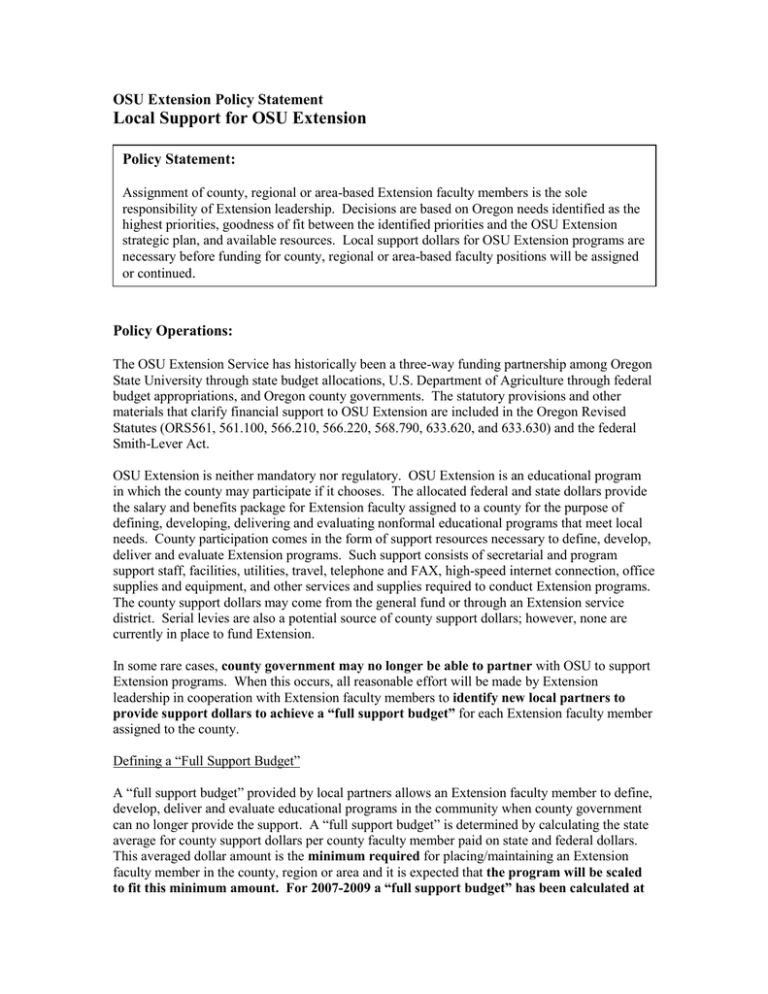Local Support Policy Statement
advertisement

OSU Extension Policy Statement Local Support for OSU Extension Policy Statement: Assignment of county, regional or area-based Extension faculty members is the sole responsibility of Extension leadership. Decisions are based on Oregon needs identified as the highest priorities, goodness of fit between the identified priorities and the OSU Extension strategic plan, and available resources. Local support dollars for OSU Extension programs are necessary before funding for county, regional or area-based faculty positions will be assigned or continued. Policy Operations: The OSU Extension Service has historically been a three-way funding partnership among Oregon State University through state budget allocations, U.S. Department of Agriculture through federal budget appropriations, and Oregon county governments. The statutory provisions and other materials that clarify financial support to OSU Extension are included in the Oregon Revised Statutes (ORS561, 561.100, 566.210, 566.220, 568.790, 633.620, and 633.630) and the federal Smith-Lever Act. OSU Extension is neither mandatory nor regulatory. OSU Extension is an educational program in which the county may participate if it chooses. The allocated federal and state dollars provide the salary and benefits package for Extension faculty assigned to a county for the purpose of defining, developing, delivering and evaluating nonformal educational programs that meet local needs. County participation comes in the form of support resources necessary to define, develop, deliver and evaluate Extension programs. Such support consists of secretarial and program support staff, facilities, utilities, travel, telephone and FAX, high-speed internet connection, office supplies and equipment, and other services and supplies required to conduct Extension programs. The county support dollars may come from the general fund or through an Extension service district. Serial levies are also a potential source of county support dollars; however, none are currently in place to fund Extension. In some rare cases, county government may no longer be able to partner with OSU to support Extension programs. When this occurs, all reasonable effort will be made by Extension leadership in cooperation with Extension faculty members to identify new local partners to provide support dollars to achieve a “full support budget” for each Extension faculty member assigned to the county. Defining a “Full Support Budget” A “full support budget” provided by local partners allows an Extension faculty member to define, develop, deliver and evaluate educational programs in the community when county government can no longer provide the support. A “full support budget” is determined by calculating the state average for county support dollars per county faculty member paid on state and federal dollars. This averaged dollar amount is the minimum required for placing/maintaining an Extension faculty member in the county, region or area and it is expected that the program will be scaled to fit this minimum amount. For 2007-2009 a “full support budget” has been calculated at $50,000 and this amount can substitute for county government support to cover the expenses required to conduct Extension programs. Because $50,000 is the statewide average, it is important to note that for some counties this dollar amount per faculty member may be greater than the amount currently received from the county. For others, $50,000 may be less than the amount received. The averaged amount allows Extension leadership to assign a faculty member to define, develop, deliver and evaluate educational programs in a community when county government can no longer provide support. It is the faculty member’s responsibility to scale the program to fit within the limitations of the “full support budget” or work with Extension leadership to find additional fiscal resources to expand and enhance the program support. Building the “full support budget” and focusing Extension programs to be successful within the “budget” requires a program business plan; resources are available to assist in its development. Partnerships are the fundamental requirement to assure Extension programs in a community when the county government is unable to provide support dollars. It is these partners who will provide a “full support budget” for each faculty member assigned and at least one of the partners must represent the local community and interests. The “full support budget” may come in a variety of forms and from multiple partners, with at least one partner representing the local community and interests. Some local partners may be able to provide cash through a contract or memorandum of understanding (MOU) in exchange for targeted educational programs. Another local partner may be able to provide office space the financial value of which can be calculated at an annual cost per square foot and included in an MOU. An Extension volunteers association may create a development fund with the OSU Foundation that will provide an annual contribution toward the “full support budget” that is confirmed with an MOU. The final piece of the “full support budget” may come from fees for Extension programs that have sufficient market value to earn a portion of the needed funds. Grants from any source may also be considered part of the “full support budget” mix, if the following three conditions are met: 1) there is a match between the mission of OSU Extension and the intent of the granting entity, 2) the dollars granted may be used for both administrative and support costs, and 3) there is a local partner representing the local community and interests. Not all faculty members are assigned to just one county. In cases where the faculty member has regional or area responsibilities per his/her position description, the “full support budget” will be based on the percentage of time assigned to the county that is not providing support dollars. For example, if an Extension faculty member is assigned quarter-time to a county not providing support dollars, then a “full support budget” to cover program expenses will equal $12,500. Defining Local Partners The decision about with whom to partner must be program-driven. The best local partners are those who have an aligned mission with OSU Extension and who share OSU Extension’s vision for the community. The best partners will likely have expertise and/or interest in the issue or problem being addressed. Potential local partners include academic, public and/or private entities that have a willingness to collaborate to achieve greater results and build community capacity. Potential partners are likely to be those agencies, organizations, associations and businesses Extension has cooperated with in the past, although this should not be a limiting factor. The local partner(s) must understand that OSU Extension delivers only unbiased, research-based information and can not promote or make recommendations about brands, products or commercial enterprises. The local partner(s) must also understand that OSU Extension provides equal program participation opportunities regardless of race, color, religion, gender, sexual orientation, national origin, age, marital status, disability and disabled veteran or Vietnam-era veteran status. Extension will not partner with an organization or group that does not support these fundamental Extension values. Extension faculty members will likely know best who the potential partners are and should make initial contact to access their interest in providing support for Extension programs. Negotiating the specifics and finalizing the needed MOU(s) is the responsibility of the local Extension administrator and/or program leader. All financial agreements require written documentation and must follow standard OSU business practices for approval. “Full Support Budget” Management The funds collected as part of a “full support budget” will be managed in the same manner as county government support dollars, with dollars sent to OSU for oversight and expenditure management. The funds will reside in a designated account at OSU for the sole purpose of defining, developing, delivering and evaluating Extension programs and related operation costs within the county or region identified. The Extension staff chair has fiduciary responsibility for the funds and is accountable for monitoring the “full support budget” to accomplish program objectives with the available resources. No Local Support Without county government participation or a “full support budget” from other local partners, Extension administration will have no choice but to close the OSU Extension office(s) within the county. A transition plan will be developed and program commitments will be reduced in a manner which will create the least amount of hardship. Specifics of how closure of the Extension office(s) will occur will vary by county, but ultimately employees funded on county dollars will be released and faculty paid on state and federal dollars will be re-assigned to another location. Alternative program delivery methods (on-line, web-based) may be explored as appropriate for the market and the subject matter. August 11, 2008
